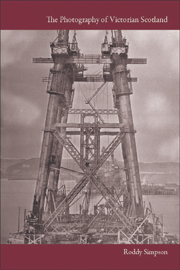Book contents
- Frontmatter
- Contents
- List of Figures
- Introduction
- 1 The Origins of Scottish Photography: Pioneering Activities in St Andrews and Edinburgh
- 2 David Octavius Hill and Robert Adamson: the ‘Partnership of Genius’ and the First Art Photography
- 3 Photography for the Few: The Activities of the Enthusiastic and Artistic Amateurs
- 4 Photography in Demand: The Work of the Increasing Number of Professional Photographers to Meet Public Demand
- 5 Scots Abroad: The Achievements of Scottish Photographers Around the World
- 6 Tourists and Travellers: Images of Scotland Produced for the Rapidly Growing Tourist Market and Photographs Taken by Visitors
- 7 Recording Social Conditions and Industrial Change: Photographs of what was Being Lost and what was Replacing it
- 8 Photography as Art: Looking at the Images and the Arguments
- 9 Populist Activity and Pictorialism: Popular Involvement with Cheap and Mass Produced Cameras and Photographers with Artistic Aspirations
- 10 Scotland's Enduring Photographic Legacy
- Bibliography
- Acknowledgements
- Index
3 - Photography for the Few: The Activities of the Enthusiastic and Artistic Amateurs
Published online by Cambridge University Press: 05 August 2013
- Frontmatter
- Contents
- List of Figures
- Introduction
- 1 The Origins of Scottish Photography: Pioneering Activities in St Andrews and Edinburgh
- 2 David Octavius Hill and Robert Adamson: the ‘Partnership of Genius’ and the First Art Photography
- 3 Photography for the Few: The Activities of the Enthusiastic and Artistic Amateurs
- 4 Photography in Demand: The Work of the Increasing Number of Professional Photographers to Meet Public Demand
- 5 Scots Abroad: The Achievements of Scottish Photographers Around the World
- 6 Tourists and Travellers: Images of Scotland Produced for the Rapidly Growing Tourist Market and Photographs Taken by Visitors
- 7 Recording Social Conditions and Industrial Change: Photographs of what was Being Lost and what was Replacing it
- 8 Photography as Art: Looking at the Images and the Arguments
- 9 Populist Activity and Pictorialism: Popular Involvement with Cheap and Mass Produced Cameras and Photographers with Artistic Aspirations
- 10 Scotland's Enduring Photographic Legacy
- Bibliography
- Acknowledgements
- Index
Summary
The prominent early photographers who practiced photography out of personal interest were at least as technically proficient as the very best commercial photographers, if not more so. They could also be inventive and experimental, taking a personal and individual approach to their photography as they were not dependent on commercial considerations.
In the privately printed book Calotypes by D. O. Hill and R. Adamson Selected from his Collection by Andrew Elliot, which was not published until 1928, although the text was written in the 1880's, John Miller Gray, the first Curator of the Scottish National Portrait Gallery, wrote about Edinburgh that ‘from the first days of photography our city has been celebrated for the number and skill of its practitioners of the art’. Demonstrating the enthusiasm for photography in Scotland from the very start, Gray goes on:
Shortly after the first discovery of the Calotype by Talbot, and its communication to Sir David Brewster, a few Edinburgh gentlemen visited the latter, saw his set of Calotypes, and were made aware of the method by which they were produced. On their return they entered eagerly on the study, and formed a little Calotype Club.
There is some vagueness about the date of the visit to St Andrews but it is estimated that the Edinburgh Calotype Club was active from about 1841 to 1856 and is claimed to be the first photographic club in the world. In a letter from Brewster to Talbot on 5 October 1841 the slow progress by Dr John Adamson with the calotype process is described but Brewster also mentions that ‘difficulties have been experienced by several persons in Edinburgh’.
- Type
- Chapter
- Information
- The Photography of Victorian Scotland , pp. 47 - 67Publisher: Edinburgh University PressPrint publication year: 2012



